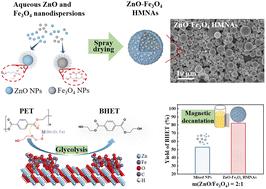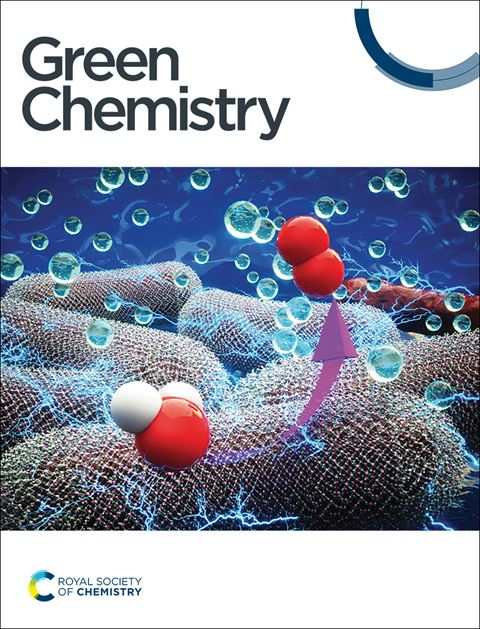磁空心微纳米聚集体协同加速PET糖酵解†
IF 9.2
1区 化学
Q1 CHEMISTRY, MULTIDISCIPLINARY
引用次数: 0
摘要
聚对苯二甲酸乙二醇酯(PET)是应用最广泛的一种聚酯,由于其在自然环境中大量且持久的积累,造成了全球性的环境问题。PET的糖酵解是机械回收的一种有吸引力的替代方法,但对高效、方便和廉价的催化剂仍然有很强的需求。在此,我们提出了一种喷雾干燥辅助方法,通过组装复合金属氧化物纳米粒子来协同解聚PET来构建磁性中空微尺度纳米聚集体(HMNAs)。所制备的ZnO - Fe3O4 HMNAs在190℃下,在30 min内完全解聚PET,单体收率高达92.3%,远高于单独的ZnO和Fe3O4纳米颗粒(NPs)。复合hnas可以在几分钟内磁性分离,并保持5个循环的高活性。DFT研究表明,hnas通过高含量的Lewis酸位点有效促进糖酵解,并且由于ZnO-Fe3O4 hnas的结构协同作用,PET与催化剂之间的吸附更强。此外,这种喷雾干燥策略作为一种通用的和可扩展的方法被扩展到制造其他hnas,表现出类似的糖酵解效率的提高。hnas有望为设计废弃塑料升级回收的催化剂开辟道路。本文章由计算机程序翻译,如有差异,请以英文原文为准。

Magnetic hollow micro-sized nanoaggregates for synergistically accelerating PET glycolysis†
Polyethylene terephthalate (PET), as the most widely utilized polyester, causes global environmental problems due to its massive and durable accumulation in natural environments. The glycolysis of PET is an attractive alternative to mechanical recycling, but there remains a strong demand for efficient, convenient, and inexpensive catalysts. Herein, we present a spray-drying-assisted way to construct magnetic hollow micro-sized nanoaggregates (HMNAs) by assembling composite metal oxide nanoparticles to depolymerize PET synergistically. The as-prepared ZnO–Fe3O4 HMNAs completely depolymerized PET with a high monomer yield of 92.3% in a short period of 30 min at 190 °C, far above individual ZnO and Fe3O4 nanoparticles (NPs). The composite HMNAs can be magnetically separated in a few minutes and maintain a high activity for 5 cycles. DFT study reveals that the HMNAs effectively facilitated glycolysis by the high content of Lewis acid sites as well as the stronger adsorption between PET and the catalyst owing to the structural synergy effect of ZnO–Fe3O4 HMNAs. Furthermore, this spray drying strategy as a versatile and scalable methodology is extended to fabricate other HMNAs, exhibiting a similarly enhanced efficiency of glycolysis. The HMNAs are expected to open up avenues for the design of catalysts for upcycling of discarded plastics.
求助全文
通过发布文献求助,成功后即可免费获取论文全文。
去求助
来源期刊

Green Chemistry
化学-化学综合
CiteScore
16.10
自引率
7.10%
发文量
677
审稿时长
1.4 months
期刊介绍:
Green Chemistry is a journal that provides a unique forum for the publication of innovative research on the development of alternative green and sustainable technologies. The scope of Green Chemistry is based on the definition proposed by Anastas and Warner (Green Chemistry: Theory and Practice, P T Anastas and J C Warner, Oxford University Press, Oxford, 1998), which defines green chemistry as the utilisation of a set of principles that reduces or eliminates the use or generation of hazardous substances in the design, manufacture and application of chemical products. Green Chemistry aims to reduce the environmental impact of the chemical enterprise by developing a technology base that is inherently non-toxic to living things and the environment. The journal welcomes submissions on all aspects of research relating to this endeavor and publishes original and significant cutting-edge research that is likely to be of wide general appeal. For a work to be published, it must present a significant advance in green chemistry, including a comparison with existing methods and a demonstration of advantages over those methods.
 求助内容:
求助内容: 应助结果提醒方式:
应助结果提醒方式:


